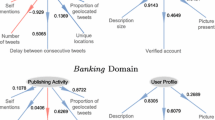Abstract
Twitter is a free social media service that allows anyone to say almost anything to anybody in 140 characters or less. Over the past few months, Twitter has experienced an explosive growth which has aroused the interest of many developers. In consequence, there have appeared many analytic tools which, besides other characteristics, calculate how influential a user is. This meaningful value can be estimated using different metrics and tools. In this paper, we study the reliability of them and show how data mining techniques can help: (a) to identify the actions which can increase the influence of a user (depending on the concrete tool), (b) to discover if those actions are related to different tools (and whether we can increase influence in more than one way), and (c) to advise people (or companies) about how they can get a greater impact.
Access this chapter
Tax calculation will be finalised at checkout
Purchases are for personal use only
Preview
Unable to display preview. Download preview PDF.
Similar content being viewed by others
References
Cha, M., Haddadi, H., Benevenuto, F., Gummadi, K.P.: Measuring user influence in twitter: The million follower fallacy. In: Proceedings of the Fourth International AAAI Conference on Weblogs and Social Media, ICWSM (2010)
Kempe, D., Kleinberg, J., Tardos, E.: Maximizing the spread of influence through a social network. In: Procc. of the 9th ACM SIGKDD International Conference on Knowledge Discovery and Data Mining, pp. 137–146 (2003)
Kimura, M., Saito, K., Nakano, R., Motoda, H.: Extracting influential nodes on a social network for information diffusion. Data Mining and Knowledge Discovery 20, 70–97 (2010)
Klout, http://klout.com/
Kononenko, I., Kukar, M.: Machine learning and data mining: Introduction to principles and algorithms. Horwood Publishing, England (2007)
Leavitt, A.: The influentials: New approaches for analyzing influence on twitter (2009), http://webecologyproject.org
Quinlan, J.R.: Learning with continuous classes. In: Proceedings of the Australian Joint Conference on Artificial Intelligence, pp. 343–348 (1992)
Twinfluence, http://twinfluence.com/
Twitter, http://twitter.com/
Twitter-Grader, http://twitter.grader.com/
Wang, Y., Witten, I.H.: Induction of model trees for predicting continuous classes. In: van Someren, M., Widmer, G. (eds.) ECML 1997. LNCS, vol. 1224. Springer, Heidelberg (1997)
Witten, I.H., Frank, E.: Data Mining: Practical machine learning tools and techniques. Morgan Kaufmann, San Francisco (2005)
Author information
Authors and Affiliations
Editor information
Editors and Affiliations
Rights and permissions
Copyright information
© 2011 Springer-Verlag Berlin Heidelberg
About this paper
Cite this paper
del Campo-Ávila, J., Moreno-Vergara, N., Trella-López, M. (2011). Analizying Factors to Increase the Influence of a Twitter User. In: Pérez, J.B., et al. Highlights in Practical Applications of Agents and Multiagent Systems. Advances in Intelligent and Soft Computing, vol 89. Springer, Berlin, Heidelberg. https://doi.org/10.1007/978-3-642-19917-2_9
Download citation
DOI: https://doi.org/10.1007/978-3-642-19917-2_9
Publisher Name: Springer, Berlin, Heidelberg
Print ISBN: 978-3-642-19916-5
Online ISBN: 978-3-642-19917-2
eBook Packages: EngineeringEngineering (R0)




